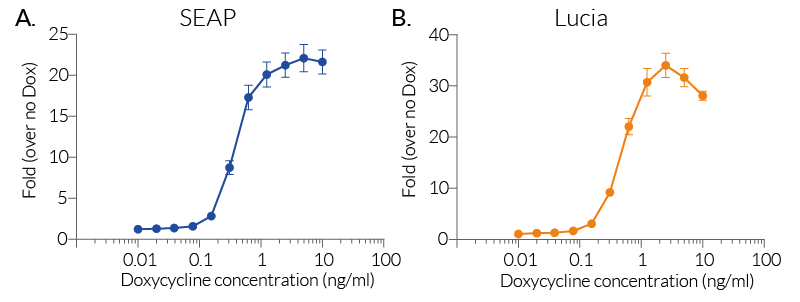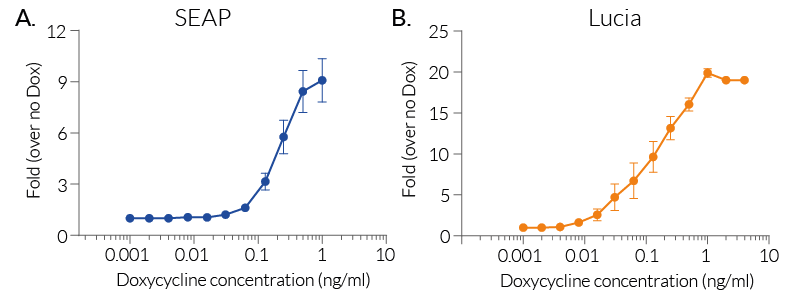Doxycycline & Blasticidin for TiGer Tet-on system
| Product | Unit size | Cat. code | Docs. | Qty. | Price | |
|---|---|---|---|---|---|---|
|
RepTor™ Reagent Kit Tet-on Inducer (Doxycycline) & Selective Antibiotic (Blasticidin) |
Show product |
10 mg dox / 50 mg blasticidin 10 mg dox / 100 mg blasticidin |
ant-doxbl-05
|
|
Tetracycline derivative and selective antibiotics for Tet-on cell lines
The RepTor™ Reagent Kit comprises two antibiotics for the induction and maintenance of InvivoGen's HEK-RepTor™ and A549-RepTor™ cells:
– Doxycycline: for inducing the TiGer Tet-on system in RepTor™ cells
– Blasticidin: for maintaining the stable expression of the tetracycline repressor (TetR) in RepTor™ cells

Key features of Doxycycline
Doxycycline is a derivative of the tetracycline antibiotic. Doxycycline and tetracycline are widely used in conditional gene expression systems, whereby expression depends on the activity of the tetracycline-responsive repressor protein (TetR). Doxycycline has been reported to have a higher affinity than tetracycline for TetR.
- Doxycycline binds with high affinity to TetR.
- Doxycycline is a potent inducer of gene expression in the TiGer Tet-on system.
- Each lot of Doxycycline is highly pure and functionally tested.
Key features of Blasticidin
Blasticidin is an efficient selection antibiotic that acts on both eukaryotic and prokaryotic cells. The plasmid encoding the TetR and the blasticidin resistance gene bsr was stably transfected into HEK-RepTor™ and A549-RepTor™ cells.
- Selection of Blasticidin-resistant cells within one week.
- Low Blasticidin concentration is required for maintaining selection pressure.
- Each lot of Blasticidin is highly pure and functionally tested.
![]() Learn more about InvivoGen's TiGer Tet-on system.
Learn more about InvivoGen's TiGer Tet-on system.
Important: InvivoGen's Doxycycline is suitable for research purposes only, and not for human or animal care.
Back to the topSpecifications
Specifications for Doxycycline:
CAS number: 24390-14-5
Formula: C22H24N2O8 . 1/2 C2H6O . HCl . 1/2 H2O
Molecular weight: 512.94 g/mol
Solubility: 1 mg/ml (1.95 mM) in water
Quality control:
- Purity: ≥95% (UHPLC)
- Biological activity has been confirmed using HEK-RepTor™ cells.
-
The absence of bacterial contamination (e.g. lipoproteins and endotoxins) has been confirmed using HEK-Blue™ hTLR2 and HEK-Blue™ hTLR4 cells.
Specifications for Blasticidin:
Quality control:
- Purity: ≥95% (UHPLC)
- Endotoxin Level: <1 EU/ml
- Physicochemical characterization: pH, appearance
- Cell-culture tested: potency validated in blasticidin-sensitive and blasticidin-resistant mammalian cell lines
- Non-cytotoxicity of trace contaminants: absence of long-term effects confirmed in blasticidin-resistant cells
Contents
The RepTor™ Reagent Kit is available in two pack sizes:
- ant-doxbl-05: 10 x 1 mg (10 mg) Doxycycline Hyclate and 5 x 1 ml (50 mg) Blasticidin Hydrochloride
- ant-doxbl-1: 10 x 1 mg (10 mg) Doxycycline Hyclate and 10 x 1 ml (100 mg) Blasticidin Hydrochloride
Doxycycline
10 x 1 mg (10 mg) Doxycycline Hyclate provided lyophilized
![]() Doxycycline is shipped at room temperature.
Doxycycline is shipped at room temperature.
![]() Upon receipt, store Doxycycline at -20 °C. Upon resuspension, prepare aliquots and store them at -20 °C.
Upon receipt, store Doxycycline at -20 °C. Upon resuspension, prepare aliquots and store them at -20 °C.
![]() Resuspended product is stable for 1 month at 4°C and for 1 year at -20°C.
Resuspended product is stable for 1 month at 4°C and for 1 year at -20°C.
![]() Avoid repeated freeze-thaw cycles.
Avoid repeated freeze-thaw cycles.
Blasticidin
5 x 1 ml (50 mg) or 10 x 1 ml (100 mg) Blasticidin Hydrochloride provided as a sterile filtered solution at 10 mg/ml in HEPES buffer
![]() Blasticidin is shipped at room temperature.
Blasticidin is shipped at room temperature.
![]() Upon receipt, store Blasticidin at 4°C or -20 °C.
Upon receipt, store Blasticidin at 4°C or -20 °C.
![]() Avoid repeated freeze-thaw cycles.
Avoid repeated freeze-thaw cycles.
![]() Blasticidin is a harmful compound. Refer to the safety data sheet for handling instructions.
Blasticidin is a harmful compound. Refer to the safety data sheet for handling instructions.
Back to the top
Details
Chemical structure of Doxycycline Hyclate

Doxycycline-mediated gene expression

Mode of action of Doxycycline
Gram-negative bacteria feature a Tn10 operon coding a tetracycline resistance protein (TetA) and a tetracycline-responsive repressor protein (TetR). These proteins share a regulatory region comprising their respective promoters as well as operator sequences (tetO) [1].
The bacteria tetracycline resistance is mediated by TetA, whose expression is controlled by TetR. TetR dimers bind the tetO elements, thus suppressing the activity of tetA and tetR promoters. The binding of tetracycline (or doxycycline) triggers a conformational change in TetR dimers. TetR proteins are released from the tetO sequences and TetA is expressed [1, 3].
In the Tet-on conditional gene expression system, TetR is constitutively expressed and a gene of interest (GOI) is placed under the control of a strong promoter and tetO elements [1, 3]. TetR binds to the tetO sequences and represses the gene transcription. Upon incubation with doxycycline, TetR is released from the tetO sequences, and the GOI is transcribed [1, 3].
References:
1. Das, A.T. et al., (2015). Tet-on systems for doxycycline-inducible gene expression. Curr Gene Ther. 16(3):156.
2. Degenkolb J. et al., (1991). Structural requirements of tetracycline-Tet repressor interaction: determination of equilibrium binding constants for tetracycline analogs with the Tet repressor. Antimicrob Agents Chemother. 35(8):1591.
3. Kallunki, T. et al., (2019). How to choose the right inducible gene expression system for mammalian studies? Cells. DOI: 10.3390/cells8080796.








